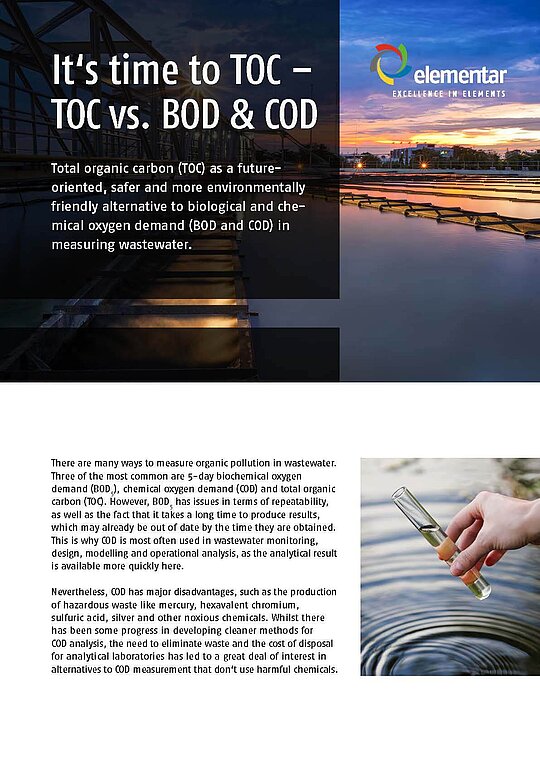Can TOC analysis change the game for wastewater processing and analysis?

Wastewater analysis plays a crucial role in ensuring human populations have access to clean, safe drinking water, and that natural water sources remain free of pollution. As such, it is crucially important that environmental researchers have access to the most accurate, sustainable and efficient tools and techniques available.
Currently, there are three main methods for measuring organic content in wastewater. For years, laboratories have relied on the tried-and-tested biological oxygen demand (BOD) and chemical oxygen demand (COD) methods to achieve this - which has meant working around the significant drawbacks associated with these techniques.
However, in more recent years, the total organic carbon (TOC) measurement method has gained prominence across many industries, thanks to its ability to overcome many of the limitations traditionally associated with BOD and COD. This is helping environmental researchers to deliver more reliable and useful insights into contamination trends and water purification efficacy around the world.
Here, we will look at why access to alternative methods is so important for wastewater analysis, and how labs can determine whether the BOD, COD or TOC method will work best for them.
Why are new alternative analytical methods needed for wastewater processing and quality control?
According to data from the United Nations, 80% of global wastewater currently goes untreated. This exposes human populations and the natural environment to all manner of pollutants, ranging from human waste to toxic industrial discharges.
The presence of pathogens, organic matter, chemical pollutants and microplastics can all make water unsuitable for human use or consumption, as well as negatively impacting marine life and local ecosystems. As such, there is a great need to invest in and improve the current treatment and analytical infrastructure for wastewater to support public and environmental health in both developed and developing nations.
Historically, the most widely-used techniques for analyzing organic pollution in wastewater have been BOD and COD, both of which have been standard practice for wastewater operations and environmental science for many decades. However, both methods have clear limitations.
BOD testing works by measuring the amount of oxygen consumed by microorganisms in one liter of water over five days, which is why it is also known as the BOD5 method. Although this approach can deliver useful insights, the five-day cycle makes BOD the slowest and most expensive of the available methods; additionally, this process has very specific pH, nutrient and chemical requirements that make it difficult for many labs to perform.
The COD method is favored by many in the industry, as it does not rely on a temperamental microbial process and takes only two to four hours per measurement, overcoming the biggest limitations of BOD. However, the COD method also has major drawbacks, as it is dependent on highly toxic and dangerous substances that are difficult to handle and dispose of, and creates hazardous waste byproducts through the process.
As such, strong demand has emerged for a cleaner, faster, less wasteful and more efficient analysis method that can present a viable alternative to both BOD and COD.
The advantages of TOC analysis over BOD and COD
TOC analysis has emerged to fill this gap in recent years. The efficiency, reliability and advanced capabilities of this method have prompted many organizations to adopt TOC as the new gold standard approach for measuring organic content in wastewater.
The method works by oxidizing the entire organic content of a liquid sample into CO2. The inorganic carbon is removed by acidification and purging, while the organic carbon components are detected and measured by a non-dispersive infrared detector (NDIR) at a specific wavelength.
This approach has been shown to deliver some key advantages compared to both BOD and COD:
- It provides accurate results within three to 10 minutes, compared to two to four hours for COD or five days for BOD
- It is a highly precise and reliable detection method, especially when analyzing complex materials found in industrial wastewater
- BOD and COD analysis works by measuring the oxygen content needed to stabilize organic matter, but these values can be highly variable based on the oxidation states of compounds within the sample; by contrast, TOC measures carbon concentrations, which remain constant, making the whole process much more reliable
- Once samples have been taken, TOC analyzers can run 24/7 and are sensitive to even extremely low concentrations of organic pollution
- The operations are clean, with no dependence on hazardous chemicals
The sensitivity, versatility and speed offered by TOC is prompting a global transition in wastewater analysis methods, with regulators in the US, India and the EU all recognizing the benefits that TOC can provide in wastewater monitoring, design, modelling and operational analysis.
Which method represents the future of wastewater analysis?
While TOC is often used to complement BOD and COD at present, rather than to replace them, it is gaining recognition as the likely de facto standard for wastewater analysis in the future. It is faster, more precise and cleaner, due to the lack of dependence on hazardous chemicals.
Furthermore, increasingly accurate detection methods are continually being developed, making TOC even more reliable and precise, especially when it comes to the more complex materials found in industrial wastewater. This is evidenced by our recent launch of enviro TOC, a new instrument that is optimized to assess TOC and TNb (total bound nitrogen) in environmental and wastewater samples.
As the world moves towards more advanced and precise testing methods, and policymakers introduce more accurate and precise parameters for water measurement, the global transition towards TOC will accelerate further. In a world of increasing industrial growth, monitoring wastewater accurately has never been more critical - and TOC is the solution to this.
Find out more
Whitepaper: TOC vs. BOD & COD
If you would like to learn more about the specific safety, reliability and environmental performance benefits that TOC can deliver compared to BOD and COD measurement for wastewater analysis, read our whitepaper:

DOWNLOAD YOUR COPY
Fill in the form to receive your download link per e-mail.
Your contractual consideration for the free provision of the download is the subscription to our personalized newsletter. By clicking on the “download now” button, you therefore declare your acceptance of the receipt of personalized newsletters by e-mail by Elementar Australia Pty Ltd and its group companies as well as the evaluation of your user behavior in this regard and - if available - the merging of this data with your data in our customer database.
In order to receive newsletters from our group companies it is necessary to transfer your above-mentioned personal data to these companies. The data transfer is contractually required.
You are aware that the subscription to our personalized newsletter represents the contractual consideration that you provide for the free provision of the download. You can unsubscribe from the newsletter at any time with effect for the future. You can object to the future use of your data for advertising purposes at any time. For further information, please refer to our privacy policy.
TOC analyzers by Elementar
You can also find out more about our range of TOC analyzers, including the enviro TOC analyzer, which is specially optimized for TOC analysis of environmental water and wastewater. With its flexibly adjustable high-temperature combustion furnace and fully automated 60-position liquid sampler, enviro TOC delivers full recovery and complete oxidation of highly stable carbon compounds, and high-throughput measurement of a wide variety of samples, complementing the inherent benefits of the TOC method.
Do not miss any new articles
NEWSLETTER
We will constantly publish new blog articles. Register for our newsletter to stay up-to-date and get informed about latest blog articles, news and trends.
